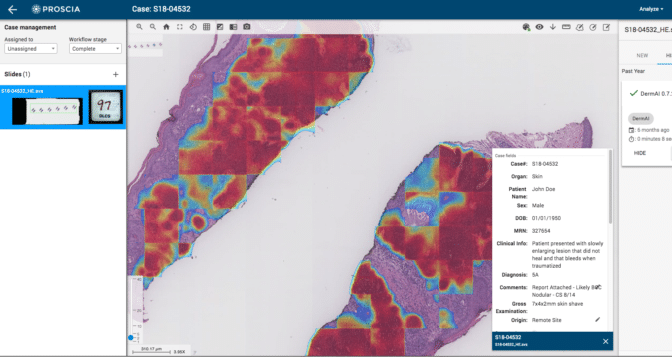AI Pathology Startup Fuels Shift Away from Physical Slides
Hundreds of millions of tissue biopsies are performed worldwide each year — most of which are diagnosed as non-cancerous. But for the few days or weeks it takes a lab to provide a result, uncertainty weighs on patients.
“Patients suffer emotionally, and their cancer is progressing as the clock ticks,” said David West, CEO of digital pathology startup
That turnaround time has the potential to dramatically reduce. In recent years, the biopsy process has begun to digitize, with more and more pathologists looking at digital scans of body tissue instead of physical slides under a microscope.
Proscia, a member of our Inception virtual accelerator program, is hosting these digital biopsy specimens in the cloud. This makes specimen analysis borderless, with one hospital able to consult a pathologist in a different region. It also creates the opportunity for AI to assist experts as they analyze specimens and make their diagnoses.
“If you have the opportunity to read twice as many slides in the same amount of time, it’s an obvious win for the laboratories,” said West.
The Philadelphia-based company recently closed a $8.3 million Series A funding round, which will power its AI development and software deployment. And a feasibility study
Biopsy Analysis, Behind the Scenes
Pathologists have the weighty task of examining lab samples of body tissue to determine if they’re cancerous or benign. But depending on the type and stage of disease, two pathologists looking at the same tissue may disagree on a diagnosis more than half the time, West says.
These experts are also overworked and in short supply globally. Laboratories around the world have too many slides and not enough people to read them.
China has one pathologist per 80,000 patients, said West. And while the United States has one per 25,000 patients, it’s facing a decline as many pathologists are reaching retirement age. Many other countries have so few pathologists that they are “on the precipice of a crisis,” according to West.
He projects that 80 to 90 percent of major laboratories will have switched their biopsy analysis from microscopes to scanners in the next five years. Proscia’s subscription-based software platform aims to help pathologists more efficiently analyze these digital biopsy specimens, assisted by AI.
The company uses a range of NVIDIA Tesla GPUs through Amazon Web Services to power its digital pathology software and AI development. The platform is currently being used worldwide by more than 4,000 pathologists, scientists and lab managers to manage biopsy data and workflows.

In December, Proscia will release its first deep learning module, DermAI. This tool will be able to analyze skin biopsies and is trained to recognize roughly 70 percent of the pathologies a typical dermatology lab sees. Three other modules are currently under development.
Proscia works with both labeled and unlabeled data from clinical partners to train its algorithms. The labeled dataset, created by expert pathologists, are tagged with the overall diagnosis as well as more granular labels for specific tissue formations within the image.
While biopsies can be ordered at multiple stages of treatment, Proscia focuses on the initial diagnosis stage, when doctors are looking at tissue and making treatment decisions.
“The AI is checking those cases as a virtual second opinion behind the scenes,” said West. This could lower the chances of missing tricky-to-spot cancers like melanoma, and make diagnoses more consistent among pathologists.
